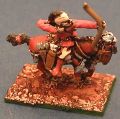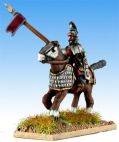Early Alan
| Navigation - HomePage - The Rise of Rome - Storm of Arrows - Immortal Fire - Legions Triumphant - Swords and Scimitars - Eternal Empire - Decline and Fall - Wolves from The Sea - Swifter Than Eagles |
Historical Overview Section
The Alans or Alani (occasionally but more rarely termed Alauni or Halani) were a sub-group among the Early Sarmatian tribes first mentioned in Mid Republican Roman literature in the first century and were described later as a warlike people that specialized in horse breeding. Ammianus Marcellinus considered the Alans to be the former Skythian or Saka Massagetae: "iuxtaque Massagetae Halani et Sargetae", "per Albanos et Massagetas, quos Alanos nunc appellamus", "Halanos pervenit, veteres Massagetas"; he stated that "Almost all of the Alans are tall and good looking; their hair is generally blond, and their eyes are frighteningly fierce", and elsewhere, "The Alans were a tall, blond people"
By the beginning of the 1st century, the Alans had occupied lands in the northeast Azov Sea area, along the Don and by the 2nd century had amalgamated or joined with the Early Horse Nomad Yancai of the early Chinese records to extend their control all the way along the trade routes from the Black Sea to the north of the Caspian and Aral seas. The written sources suggest that from the second half of the 1st to 4th century the Alans had supremacy over the tribal union and created a powerful confederation of Sarmatian tribes.
From a Western point-of-view the Alans presented a serious problem for the Late Republican Roman and then Principate Roman Empire, with incursions into both the Danubian and the Caucasian provinces in the 2nd and 3rd centuries. They also frequently raided the Parthian empire. Flavius Arrianus marched against the Alani in the first century and left a detailed report (Ektaxis kata Alanoon or 'War Against the Alans') that is a major source for studying Roman military tactics, but doesn't reveal much about his enemy.
Around 370, the Alans were overwhelmed by the Western Hunnic Huns. They were divided into several groups, some of whom fled westward. A portion of these western Alans joined the Germanic Early Visigothic and Early Vandals tribes and and Sueves in their invasion of Dominate Roman Gaul. Settled in Gaul, the Alans of Orléans played a critical role in helping the Foederate Romans to repel the invasion of Attila the Western Hunnic leader at the Battle of Chalons. After the fifth century, however, the Alans of Gaul were subsumed in the territorial struggles between the Lombard Franks and the Later Visigothic tribes, and ceased to have an independent existence. Other groups went into Spain taking advantage of the power vacuum created by the incursion of the African Vandals. In 417 an Alan king, Attaces, was killed in battle against the Later Visigothic Visigoths, and the Spanish Alans chose to become subjects of the African Vandal king Gunderic. Most of the Alans went to North Africa with the African Vandals in 429. Later Vandal kings in North Africa styled themselves Rex Wandalorum et Alanorum ("King of the Vandals and Alans"). Yet more Alan tribes moved northeast and settled among the Early Slavic tribes, later assimilating into the Slav population. In the seventh century the Serbs and Croats migrated into the western Balkans, supposedly at the invitation of the Early Byzantine Emperor Heraclius, and settled there among earlier Slavic migrants to become ancestors of the modern Serbs and Croats.
Using the army in FoG
- With three troop types its never going to be complex. The entire army should be thought of as essentially a delivery mechanism for 30 lancer armed superior cavalry to the optimum point in the enemy line. Fleeing the LH off table if pressed is a tactic to bear in mind. The 12 foot archers look cheap, but may be a distraction for an army which wants little if any terrain, and could be caught and cheaply killed.
- Armoured Superior Lancers rock. do rut they are expensive. As undrilled troops you need a simple plan, as enemy with drilled cavalry will try to exploit your flanks and position themselves for flank intercept charges using the “move full speed then turn 90 degrees†with columns of drilled lancers.
- The big issue is protecting the flanks of your line of charging lancers. Some armies can simply do this with yet more lancers, accepting attrition along the way – and this should not be discounted as your support troop options are limited. The LH can do a good job, but don't get carried away buy buying too many every LH Bg that dies means one BG of lancers may not even get into combat before the army breaks. Likewise with the option to field them as cavalry - they shoot more, but are vulnerable and can't evade as well as LH. 8 LF can form a good screen in front of lancers to protect them from shooting.
- The ideal combination for lancers is a mix of 4’s and 6’s, using the 6’s as the sledgehammer to take casualties and not suffer the -1 for losing 25%, and also to last longer before autobreaking. Lancer Cavalry also ideally need generals to help them in combat, and so having a general with a 6 is better value. Your lancers can also help your LH to hunt enemy LH, with combined Lancer/LH charges that enemy LH have to flee from, and where your own LH may be able to catch the flee-er’s.
- The extra flexibility of 4's for your cavalry can allow them to squeeze through gaps and down flanks.
- An FC can flank march with an extremely good chance of success, allowing you to overwhelm an enemy down one flank even more swiftly.
- You need to concentrate on stripping as much terrain as possible from the table. Concentrate your lancers down one of the flanks, with a couple of LH if he has LH and LF, so that you can catch him with your LH as he will not dare stand against your lancers. Pick on little bits of his army with the rest of your LH to shoot it down and maybe get a charge against fragged troops. Don't risk too much doing this though as it is still a small army, so skirmish when needed.
- One question for the list is whether you would prefer to emphasize shooting and skirmishing against an opponent and then exploiting a weak spot or to just skirmis/ screen part of an opponents army while attempting to quickly crush the remainder with massed lancers. If you are planning to play the Alans based on having used Scythians in other rules, it might make more sense to go for the first approach and therefore emphasize light troops (LH and LF) compared to the number of lancers. If you want the second approach, then reverse that emphasis.
UK Tournament Results with this army
Useful Links
User-contributed links about this army:
- Register and you can put you own link in here and then write some brief detail about the link here
- Register and you can put you own link in here and then write some brief detail about the link here
- put the link text readers will see in here write some more detail about the link here
15mm Manufacturers supplying figures for this army
You can see some of the figures in the Ancients Photo Gallery also on this site
|
|
|

|

|

|
|

|
You can see some more of the figures in the Ancients Photo Gallery also on this site
- Essex Miniatures
- Donnington
- Museum Miniatures codes SE14 & SE24 for the foot
- Old Glory 15's,
- Magister Militum
- Lancashire Games
- Peter Pig
- Irregular Miniatures
- AlainTouller Figurines - some Scythian horse could be used
- Tin Soldier
- Minifigs
- East Riding Miniatures
- Isarus - sold by 15mm.co.uk
- Outpost Wargame Services
- Khurasan Miniatures - nice newish Sarmatian range
- Viking Forge
- Hall of Ancient Warriors
- Falcon Figures (Skythian ranges)
Core Troops
Which troops are absolutely needed for this army, and what are your thoughts on how to organise, paint and buy them.
Army Lists
Sample army lists for this army
Name of Army / Date
- 1xIC; 1xFC; 2xTC @ 200 pts
- 5 BGs of 4 Lancers, Armoured, Sw, superior @ 320 pts
- 7 BGs of 4 LH, Bw, Sw, average @ 280 pts = 800 points maximum.
Or - drop a TC and upgrade a LH unit to more lancers!
eBay Listings
UK Bookstore